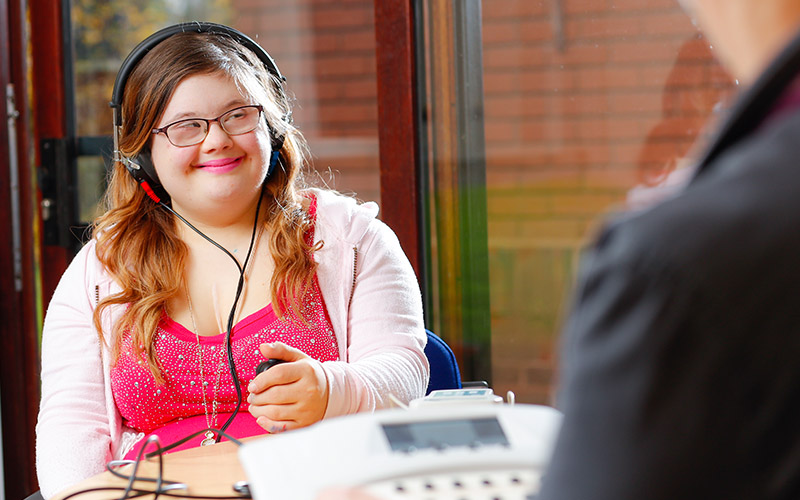Life skills
Support with eye and ear health care
 Vision and hearing are the main senses we use to learn about, and interact with, our environment.
Vision and hearing are the main senses we use to learn about, and interact with, our environment.
They are distance senses, allowing us to experience and enjoy the world without the need to get up close to people and objects.
They are vital for a person to be as independent as possible, especially for confident and safe mobility.
People with limited mobility are even more reliant on their vision and hearing to engage and interact with the world.
- support people with learning disabilities, and the people who support them, to understand the importance of regular eye checks and hearing checks
- provide familiarisation programmes that help a person become accustomed to eye checks and hearing checks
- explain how regular checks can be adapted to meet the needs of the person, and what can still be achieved if accessing a mainstream service isn’t possible
- offer tips on identifying vision or hearing loss and avoiding diagnostic overshadowing.
How the right support can make such a difference: Video of Leanne’s story from SeeAbility.
- with support teams, create bespoke guidelines to help a person manage their vision or hearing impairment, and to make best use of their residual senses
- create and provide accessible / easy read information that can help a person and their support team understand their vision or hearing condition and what it may mean for them in their everyday lives.

Signposting
- explain which service may be able to offer further support, and how they would do this
- refer a person on to other services – either with informed consent or in their best interest
Training
- vision and hearing awareness training sessions for families and support staff. These include practical tasks that can support a more empathetic approach
- bespoke training, where appropriate
- provide resources to give supporting staff and families the tools they need to support someone to manage their vision and/or hearing loss.
Life changes
 Health
Health
Prevalence of visual impairments in learning disabilities is higher than the general population, as is hearing impairments.
- promote assessment of a person’s hearing every two years as per NICE guidelines
- identify those who are at further risk of visual or hearing impairment, such as Downs Syndrome
- offer information on promoting eye and ear health.
Transitions
- work with schools and other children’s services to promote awareness and knowledge of the children’s and adult teams
- support a person to move home and make sure it meets their visual or hearing needs.
Environment
- assessment and recommendations on adapting current or future environments to meet someone’s visual or hearing needs.
- top tips for making simple adaptations at home
- Example of an environmental assessment report.
Mental capacity
- work with a person and their support team to aid understanding of a visual or ear condition, and any proposed treatment
- advocate and support a person through any best interest decision making, ensuring that the principles of the Mental Capacity Act have been followed.
Living well
 Wellbeing
Wellbeing
Assessments don’t always just focus on a particular health need they take into account the wellbeing of the person and the people who support them.
The service wants to reduce health inequalities for the people with a learning disability, and we use the Health Equality Framework to help us identify areas where further support could be offered to reduce this inequality.
Safety
Risk assessments – not only to identify and reduce risk where reduced visual or hearing ability may impact on a person’s life – but also to identify the risks of a person not accessing a mainstream service, for example, missing the early detection of glaucoma.
Tackling Diagnostic overshadowing – this is where “…symptoms arising from physical or mental health problems are misattributed to an individual’s learning disability, leading to delayed diagnosis and treatment…”.
Independence
A person should be supported to live as independently as possible. A person’s vision and hearing contributes greatly to being able to make everyday decisions and maintain independence as much as possible.
- offer resources and training on early identification of visual and hearing impairment
- offer useful tips on what to do / not to do to promote good eye and ear health
- suggest other resources that can help promote good eye and ear health, such as phone / tablet apps
Tips for supporting someone with a hearing loss
Taken from ‘Hearing loss in people with learning disabilities’ by Lynzee McShea, 2013
- One or both ears small or unusually shaped.
- Ear discharge or unpleasant odour from ears.
- Ear wax visibly building up / blocking ear canal.
- Raised volume of speaking voice.
- Poor communication skills.
- Hears better when facing the person speaking to them.
- Needs visual prompts / gestures to aid understanding.
- Has difficulty hearing in group situations or with background noise present.
- Poor concentration, loss of skills, apparent confusion.
- Unresponsive to people from a distance.
- More responsive to speech / sound from left or right side.
- Frequent pulling, rubbing or poking of ears.
- Hitting or slapping side of head.
- Has the TV on louder, or sits closer to it.
- Cannot identify which direction a sound has come from e.g. looking wrong way when name is called.



